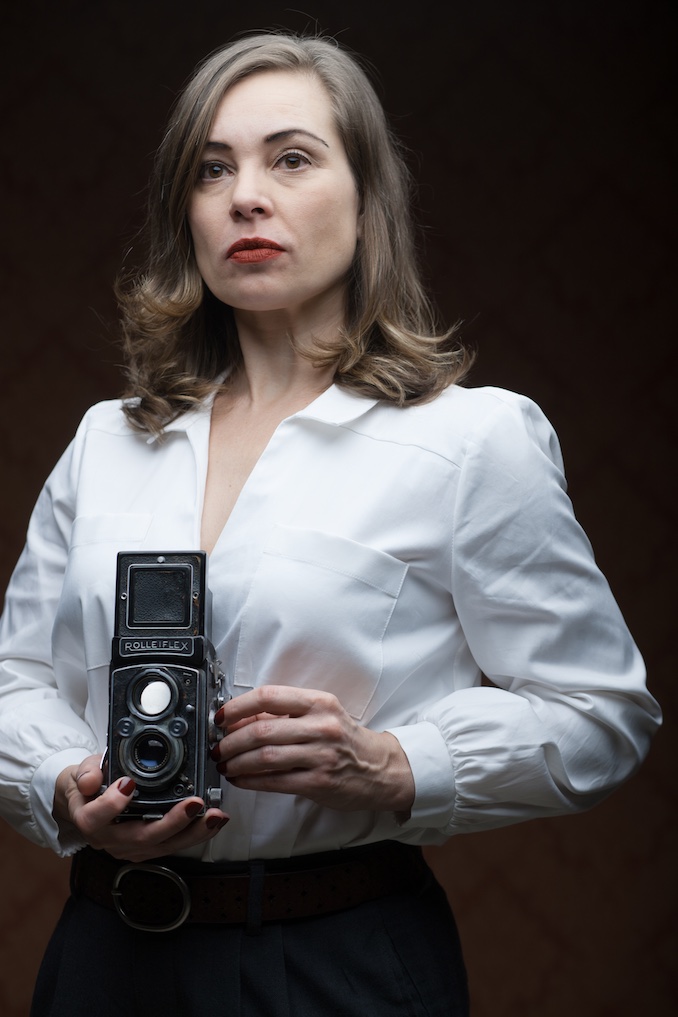Solo-person shows are difficult to pull off. One challenge lies in creating good enough material to keep an audience engaged. A second challenge lies in the actor. Are they dexterous and versatile enough to meet the writing? Can they meet the challenge of being on stage all alone? Finally, can a director harness enough theatrical activity from the material to keep it compelling?

Dora Maar: The Wicked One, escapes all these pitfalls. Expertly conceived and written by Beth Graham and Daniela Vlaskalic and starring Vlaskalic herself, the play showcases a fascinating biography of Dora Maar, the brilliant photographer and artist who becomes just one of many mistresses of the famous painter, Pablo Picasso. Much of the play details Maar’s obsession with Picasso, his incessant philandering, their mutual artistry, and a keen interest in surrealism.
Much of what makes this play compelling lies in the conflict between muses and artists. He paints her, while she photographs him. She inspires his work, he inspires hers. The love affair brings extra fire to this equation. And as various other women enter Picasso’s paintings as subjects, Maar herself becomes trapped in a horrid funhouse of his objectivity. It’s her desire to be seen in her own right that propels much of this play.
An important aspect that makes this material compelling is the introduction of a cleverly written subplot that details the myth of Daedalus, Icarus, and the Minotaur. This interweaving of myth and Maar’s story creates a pastiche that becomes the literary equivalent of surrealism as myth and reality bleed into one another. The addition of this mythical text into Maar’s story is a wise one especially as it pertains to the Minotaur. Picasso was known to be deeply fascinated by this beast with a man’s body and a bull’s head. Graham and Vlaskalic deftly make use of this imagery by making Maar the matador to Picasso’s bull, again calling into question muse vs. artist, but also love vs. danger.
Vlaskalic disappears into Maar. She’s a likable actor with excellent range and does a fine job of conveying Maar’s confidence as an artist. She stalks the stage playing multiple characters. Sometimes those characters play other characters. A good example of this occurs when Vlaskalic playing Maar imitates Picasso’s impersonation of his Russian ballerina wife, Olga. This is more than just a functional way to make a solo performance entertaining. This is thematically tethered to surrealism itself, as character, actor and text become collages of each other.
Vlaskalic’s performance is aided by Blake Brooker’s subtle direction, which might be the most interesting conceit. Utilizing minimalism to its fullest potential, Brooker puts Vlaskalic in charge of moving two rolling Mickey-Mole lights around the stage to light herself from various angles. Because much of this play deals with trying to get out from under Picasso’s shadow, the idea of constructing one’s performance through lighting is intriguing. It literally shows a determination to be seen in her own light. In this sense, the performance of Maar becomes meta-theatrical. Is Brooker crafting the image that Maar the artist is trying to construct of herself? Are Picasso and Maar creating one another through photography and painting? This is the hallway of mirrors the text presents us with. That all these ideas can be expressed through a solo performance is even more impressive.
If there is something problematic about this piece, it’s this: for a project that spends an inordinate amount of time in its promotional materials making the case of why Maar is a worthy artist in her own right, we hear way too much of Picasso and his brilliance during the play, and we don’t hear enough about her credibility as an artist.
I keep thinking of Peter Shaffer’s Amadeus. Why do we know Mozart is a genius? Because we see the realization demonstrated on Salieri’s face. And then it’s backed up in speech. Salieri is the antagonist. If Salieri believes Mozart is a genius, then the audience has no problem believing the same thing. In Dora Maar: The Wicked One, nobody does this for her. We don’t see her genius represented through the eyes of others. She’s never given a revelatory moment of her own genius.
Of course, it’s difficult to build outside credibility when you’re the only person on the stage.
***
*Special thanks to Megan Dyck and Tristan Zastrow for giving me a quick tutorial and background in surrealism.
Dora Maar: The Wicked One is playing in the Big Secret Theatre at Arts Commons May 5th-May 14th, 2022. The running time is 90 minutes with no intermission. It is co-produced by GAL Productions and Hit and Myth under the umbrella of High Performance Rodeo as part of the Calgary International Festival Of The Arts, Spring Edition




